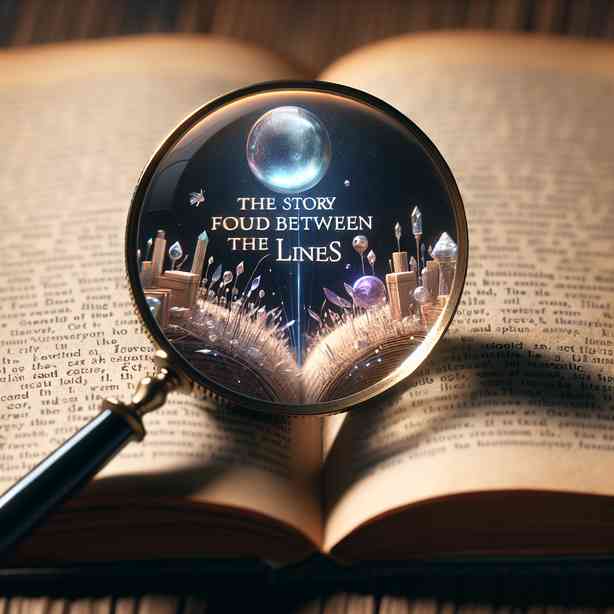
In the evolving world of literature, the notion of finding stories hidden between the lines is a theme that invites deep exploration. These hidden tales often reveal not just the narratives penned by the author, but also the reflections of society, culture, and the intricate human emotions that bind us together. The subtle nuances in writing can bring forth an array of interpretations, making literature a treasure trove for readers prepared to delve deeper.
When we approach a piece of literature, we often limit ourselves to the surface-level understanding of characters, plots, and settings. However, significant meaning often lies beneath this initial layer. Authors frequently use metaphors, symbolism, and allegory to convey messages that resonate on multiple levels. By examining these elements, readers can uncover profound truths about the human experience, societal challenges, and the intricate dynamics of relationships.
Consider the use of metaphor in a literary work. Metaphors allow authors to create vivid imagery and evoke emotions that may not be explicitly stated. For instance, when an author describes a character’s heartbreak as a shattered mirror, the visual representation not only illustrates the pain but also reflects the brokenness of self-perception and identity. Such imagery encourages readers to think profoundly about their own experiences and the plural meanings of love, loss, and recovery. Thus, by taking the time to analyze metaphorical language, we can find stories between the lines, enriching our reading experience.
Furthermore, symbolism plays a crucial role in revealing layers of meaning. Objects, colors, or actions can carry significant weight, representing broader themes and emotions. A blue sky might symbolize hope and freedom, while a stormy setting may denote conflict and inner turmoil. This duality urges readers to engage analytically with the text, encouraging them to decipher what these symbols signify within the larger context. As we reflect on such symbols, we find stories that embody resilience, despair, aspiration, and fear—all essential facets of the human experience.
Another profound aspect of storytelling lies in the characters themselves. Authors often craft characters that embody complex human traits, making them relatable yet multifaceted. Their struggles, victories, and transformations can mirror the reader’s own journey. For instance, a character overcoming adversity may inspire hope and determination, while another character’s descent into despair may act as a cautionary tale. Through this, the readers discover that their personal narratives resonate with those found in literature, bridging the gap between fiction and reality. This shared humanity elevates the reading experience, allowing for a deeper connection with the text.
Additionally, dialogue within the literature serves as a powerful tool for revealing underlying themes and dynamics. The spoken words between characters can expose societal norms, power struggles, and emotional complexity. By paying attention to what is said—and what is left unsaid—readers can unearth crucial insights. The subtleties of dialogue bring to light conflicts, desires, and fears that shape human interaction. It is through dialogue that we often grasp the unspoken narratives that exist beneath the surface of the primary story.
As we engage with literature, we must also acknowledge the historical and cultural frameworks at play. An understanding of the time and place in which a work was created can illuminate why certain themes appear and how they resonate with audiences. Literature is often a reflection of the society and era in which it was produced, encapsulating the prevailing ideologies, struggles, and aspirations of its time. Therefore, recognizing the historical context enables readers to engage with the text on a deeper level, uncovering layers of meaning that inform the narrative and characters.
The act of reading itself can be transformational. It allows individuals to explore diverse perspectives, challenging their own preconceived notions and biases. By stepping into the shoes of various characters, readers can cultivate empathy and understanding. As we absorb these different viewpoints, we discover not just the stories existing within the lines, but also the broader narrative of humanity. This journey through literature encourages introspection and promotes growth, making it an integral part of our development.
Moreover, engaging in discussions about literature can further enhance our understanding of the stories between the lines. When readers come together to share their interpretations, they expose one another to fresh perspectives. Such conversations create a communal space for exploring themes, symbols, and character motivations. Discussion invites debate, resulting in a richer understanding of the text. This exchange of ideas allows readers to discover hidden gems within the narrative that they may not have considered on their own, further exemplifying the collaborative nature of literature.
In addition to the collective experience of reading and discussing literature, writing about it can also yield new insights. Keeping a reading journal, participating in book clubs, or even blogging about a literary work can help crystallize thoughts and emotions stirred by the text. This reflective practice invites contemplation and encourages readers to articulate their interpretations. Through writing, individuals can unearth personal connections to the narratives, thereby appreciating the stories intertwined within the lines even more.
As we conclude our exploration of the stories that lie between the lines, it becomes evident that literature is much more than mere words on a page. It serves as a mirror reflecting the human experience, a vessel for conveying emotion, and a tool for introspection and growth. The layers embedded within texts invite readers to engage deeply, urging them to question, reflect, and connect with the stories that resonate with their own lives. The journey through literature is indeed one of discovery—a pathway that leads us to a greater understanding of ourselves and the world around us.
In embracing this literary journey, we cultivate our ability to discern the layers of meaning within narratives, ultimately enriching our experiences both in reading and in life. The stories hidden between the lines are not just mere tales; they are reflections of the complex tapestry of human existence, waiting to be unraveled by those daring enough to venture beyond the surface.


